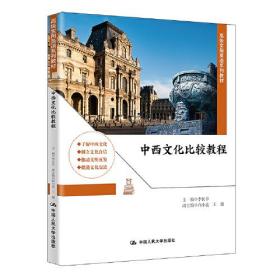
中西文化比较教程
全新正版 极速发货
¥ 16.66 5.0折 ¥ 33 全新
库存4件
广东广州
认证卖家担保交易快速发货售后保障
作者叶胜年
出版社上海外语教育出版社
ISBN9787544617970
出版时间2010-12
装帧平装
开本其他
定价33元
货号1200020380
上书时间2024-09-07
- 最新上架
商品详情
- 品相描述:全新
- 商品描述
-
目录
CHAPTER 1 Introduction
1.1 Motivations and grounds for making comparative studies
1.2 The essentials of comparative culture in the present book
1.2.1 The leading role of ideology
1.2.2 Literature and art as part of cultural tradition
1.2.3 A variety of cultural subjects
1.3 Gap yet to be bridged
CHAPTER2 A Comparison of Ancient Chinese and Western Philosophies
2.1 A survey of ancient Chinese philosophy
2.1.1 Confucianism
2.1.2 Taoism
2.1.3 Legalism
2.1.4 Mohism
2.2 A survey of ancient Western philosophy
2.2.1 The inception of Western philosophy
2.2.2 The representative figures or schools
2.3 Comparative comments
2.3.1 Economic.political and intellectual circumstances
2.3.2 Philosophical and academic ideas
2.4 A case study
2.4.1 Setting for the birth of Confucius and Socrates ideologies ...
2.4.2 Personal and academic experiences
2.4.3 Religious faith
2.4.4 Political views
2.4.5 Philosophical and cognitive issues
2.4.6 Ethical ideas
CHAPTER 3 A Comparison of Middle-Age Chinese and Western Philosophies
3.1 So and intellectual background
3.2 Chinese representative philosophies
3.2.1 Fan Zhen
3.2.2 Zhu Xi
3.2.3 Wang Shouren
3.3 Western representative philosophies
3.3.1 Neoplatonism
3.3.2 Scholasticism
3.3.3 The Christian Reformation and Martin Luther
3.4 Comparative comments
3.4.1 The establishment and defence of the orthodox ideology
3.4.2 Historical reasons behind the faiths
3.4.3 The view of Confucianism and Christianity
3.4.4 Influence on the attitude towards nature and learning
3.4.5 Mysterious and religious factors within the ideological tendency
3.5 A case study
3.5.1 Motivation for scholarly modifications
3.5.2 Epistemology and metaphysics
3.5.3 Ethical principles
3.5.4 Political.so and intellectual concerns
CHAPTER 4 A Comparison of Modern Chinese and Western Philosophies
4.1 So and intellectual scene for modern philosophy
4.2 The Chinese representative thinkers
4.2.1 Wang Fuzhi
4.2.2 Gong Zizhen
4.2.3 Kang Youwei
4.2.4 Sun Yatsen
4.3 The development of modern Western philosophy and its representative figures
4.3.1 The Renaissance: F. Bacon and T. Hobbes
4.3.2 Empiricism and J. Locke
4.3.3 J. Rousseau and the French Revolution
4.3.4 J. Mill.F. Nietzsche and the dawn of the new era 2
4.4 Comparative comments
4.4.1 So and intellectual conditions
4.4.2 Contribution to so progress
4.4.3 Philosophical and so significances in theoretical exploration
4.4.4 Critical spirit
4.4.5 The range and depth of intellectual influence
4.5 A case study
4.5.1 A reflection on so change
4.5.2 Strong sense of critical spirit
4.5.3 So and intellectual analyses
4.5.4 Political significance in academic study
CHAPTER 5 A Comparison of the Chinese and English Languages
5.1 The origin and development of the Chinese and English languages
5.1.1 The development of the Chinese language
5.1.2 The development of the English language
5.2 The main features of the Chinese language
5.2.1 The ideographic language in general
5.2.2 Flexibility in sentence structure
5.2.3 Sense of tense and inflection
5.2.4 Elliptical elements
5.2.5 Chinese as a tonal language
5.2.6 Chinese pronunciation
5.2.7 Chinese vocabulary
5.2.8 Chinese grammar
5.3 The main features of the English language
5.3.1 Shape-and-inflection structure
5.3.2 Sound-identified language
5.3.3 Accent as the sign for differentiation in meaning or part of speech
5.3.4 The constitution of a variety of rhyme and rhythm
5.3.5 The expansion of vocabulary by borrowing from other languages
5.3.6 Varieties of English established in the modern age
5.4 Comparative comments
5.4.1 The origin of the two languages
5.4.2 Diverse linguistic applications and features
5.4.3 Historical changes in language form
5.4.4 Psychological and aesthetic effects of the two languages
5.4.5 External influences
5.4.6 Academic study
CHAPTER 6 A Comparison of Chinese and Western Poetry
6.1 An account of the development of Chinese and Western poetry
6.1.1 The story of Chinese poetry
6.1.2 The story of Western poetry
6.2 Central concerns in Chinese and Western poetry
6.2.1 Political issues
6.2.2 So concerns
6.2.3 Personal concerns
6.3 Aesthetic sense in poetic production
6.3.1 Emotional touches on various occasions
6.3.2 Awareness of natural charm
6.3.3 Philosophical meditations
6.3.4 Imagination
6.3.5 Cultural taste
6.3.6 So satire
6.4 Poetic form
6.4.1 Sound pattern
6.4.2 Imagery
6.5 A case study
CHAPTER 7 A Comparison of Chinese and Western Fictions
7.1 Historical development of Chinese and Western fictions
7.1.1 An account of fiction development in China
7.1.2 An account of Western fiction development
7.2 General sense of fiction as a literary genre
7.2.1 Story development in early fiction
7.2.2 Historical aspect of fiction
7.2.3 Moral value of fiction
7.2.4 So significance of fiction
7.2.5 "Preparation for modern fiction
7.3 Central concern and subject matter
7.3.1 Historical and political concerns
7.3.2 So convention
7.3.3 Love romance
7.3.4 Myth and supernatural tales
7.4 Writing methods
7.4.1 Language features
7.4.2 Narrative structure and perspective
7.4.3 Characterization and psychological writing
7.4.4 The use of imagery and other rhetorical devices
7.4.5 Satirical and.~ critical tone
7.5 Case studies
7.5.1 A comparative study of sanoguo-yan-yi and War and Peace
7.5.2 A comparative study of hong-lou-meng and The Sound and the Fury
CHAPTER 8 A Compa
相关推荐
— 没有更多了 —



















以下为对购买帮助不大的评价